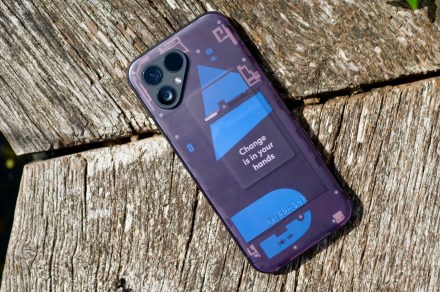
“The Fairphone 5’s sustainability and longevity set it apart from the competition, but a poor camera and short battery life affect its desirability.”
Pros
- Impressive planet- and people-friendly credentials
- Years of software updates promised
- Repairable at home
- Replaceable battery
- Fast, clean software
Cons
- Terrible wide-angle camera
- One-day battery life
- No wireless charging
I’m willing to bet the reason you are looking at the Fairphone 5 as your next phone almost certainly isn’t because of the camera, performance, screen, or processor. It’s because of Fairphone’s commitment to the planet, sustainability, and treating those who work for the company and who make its devices fairly — and the fact it’s an electronic device made to be kept for many years.
This makes my job more complicated than usual, as I can’t “test” these aspects, but Fairphone explains all its efforts in detail on its website. What I can tell you is if the Fairphone 5 does its job today, whether it keeps pace with competing phones, and whether you’ll be desperate to immediately replace it because it’s annoying or underperforming. The Fairphone 5 is unlike any other phone out there, and there are a lot of positives to it. But you really are going to have to get behind its sustainability and fairness philosophy in order to buy it, because there are two pretty serious downsides to consider.
What makes the Fairphone 5 different?
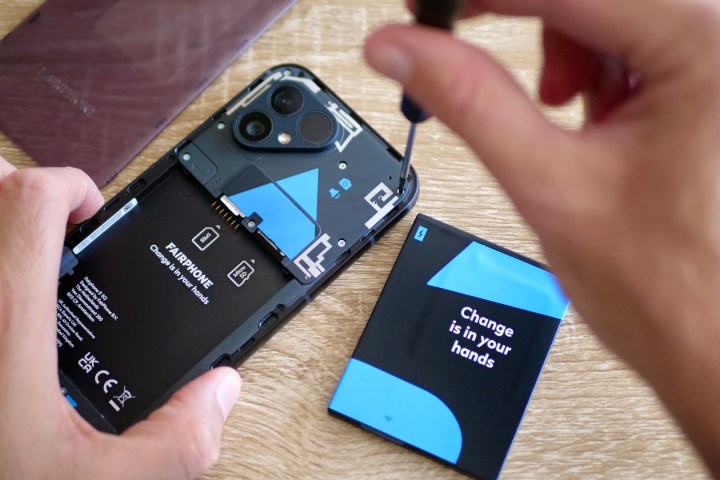
Fairphone is committed to making a phone that you can keep for many years, which it does so through software updates and repairability. I can’t test the software update policy, but it’s very impressive on paper. Fairphone says it will update the Fairphone 5’s Android software until 2031, with at least five major Android version updates coming during this time. It also hopes to extend support for another two years beyond this, potentially providing 10 years of support in total. It’s an extremely ambitious commitment, given industry powerhouses like Samsung can only manage four years of major software updates and five years of security updates.
You can also repair the phone yourself if certain parts break. This includes the screen, the USB port, the camera, and the battery. Parts are sold through Fairphone’s website and are not obscenely priced, with a screen being the most expensive part at 100 euros, or about $108. I was sent a special screwdriver (which usually has to be purchased separately) with my review phone, so I could take the device apart. However, I wasn’t sent any replacement parts to try out or any instructions, so I went in a bit blind.
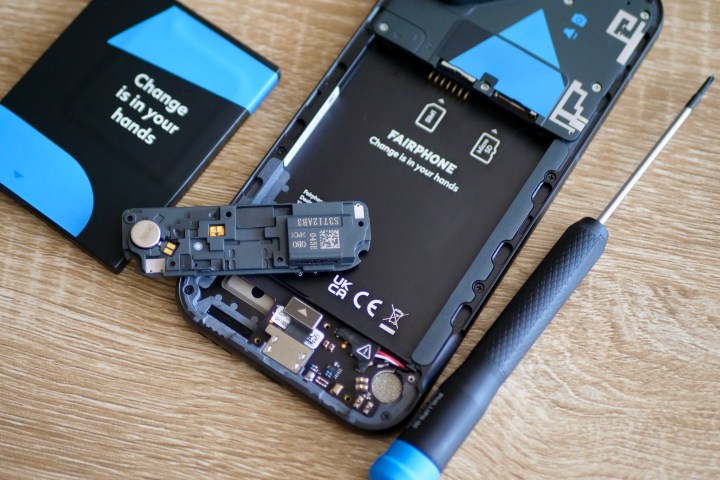
And you know what? It wasn’t bad at all! The plastic rear panel unclips, and the battery can be quickly removed, revealing the SIM slot and a MicroSD card slot too. All you need to continue is the 00 Phillips screwdriver and perhaps a small spudger tool to make component removal more comfortable. The screws are tiny, but sensibly split into two groups (silver and black) to make it easier to remove the right section. It needs a steady hand, but it never feels like you’re doing anything that’s not allowed or that will end up breaking the phone.
It’s not complicated or that time-consuming, and based on being able to take it apart like this, I think most people could easily replace parts on the Fairphone 5 with a little patience. Combine this repairability with the very long software commitment, and you could feasibly keep your Fairphone 5 for eight years, with it still looking and functioning like a new, up-to-date smartphone. It’s a big deal, and a unique proposition in the smartphone world.
The Fairphone 5’s battery problem
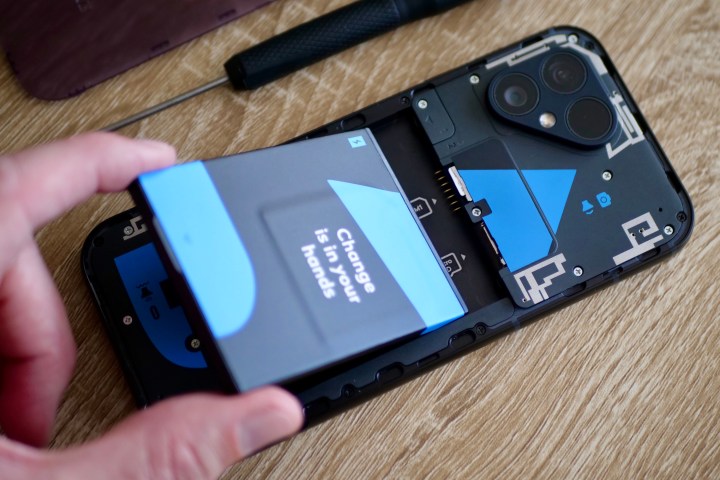
The Fairphone 5 will almost certainly last you for years, but it won’t last you for days. The one aspect of longevity where the Fairphone 5 fails is battery life. Even with modest use, the phone will only last a single day, and if you push it hard, it’ll struggle to do even that. I’ve averaged between three and four hours of screen time per day, and by about 11 p.m., the battery usually has around 15% remaining. The 4,200mAh cell’s capacity isn’t tragic and is actually larger than the one in the Samsung Galaxy S23, but when many flagship phones now have batteries that last for two days, it feels restrictive.
When I first started using the Fairphone 5, I was concerned that the efficiency of the Qualcomm QCM6460 processor — a 2.7GHz, 64-bit, octa-core Enterprise processor that was chosen over a conventional Snapdragon or MediaTek Dimensity for its ability to be updated for longer than a normal mobile chip — would cause the battery to suffer. However, that doesn’t seem to be the case. I used the 3DMark benchmarking app’s Wild Life Extreme Stress Test, and although it was very jerky at a mere five or six frames-per-second throughout, the 20-minute session saw the battery reduce from 86% to 77%. This is in line with what I expect from any modern phone.
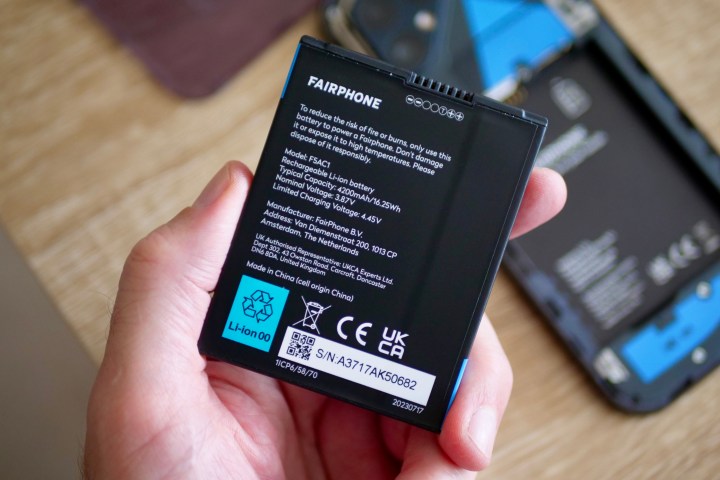
Temperatures stayed under control too, with only the chassis becoming slightly warm to the touch, so there’s nothing wrong with the thermal management. It seems the shorter-than-hoped-for battery life is due to the cell’s capacity, and perhaps the display, as I’ll come to later, rather than inefficiencies caused by the use of a nontraditional smartphone processor.
There’s no fast charging to rival phones like the OnePlus 11 either. The Fairphone 5 charges at a 30-watt maximum, and my Anker GaN charger took it to 50% in about 30 minutes, but it took far longer to reach 100%. In total, it took almost 90 minutes to fully charge, but only because the final 7% bizarrely took 25 minutes on its own. The phone doesn’t have wireless charging due to its repairability.
While it’s a bit slow to charge and there’s no wireless charging, what it does have is a removable battery, and as Fairphone sells replacement batteries for 40 euros/$43, you could buy a few and carry them around just like it was 2009. It’s not the most “modern” or elegant solution, but it is a solution to the Fairphone’s slightly disappointing battery life.
What about the Fairphone 5’s design and durability?

The final part of the longevity puzzle is the hardware itself. Although it shares basically the same design as the Fairphone 4, it’s a good-looking smartphone, with the triangular camera module looking suitably unusual and giving the phone an identity of its own. The chassis is made of metal, but the rear panel is flimsy plastic, and it’s really noticeable when you pull it away from the body.
I love the transparent look of my review model, with its stamped, indented Fairphone logo. A Sky Blue or Matte Black version is also available, if you’d rather have something more subtle without the “Change is in your hands” script visible and making a statement. The fingerprint sensor in the power key is fast and easy to locate with your finger, although the phone is thick and slab-like at 9.6mm and surprisingly heavy at 212 grams. It’s not fatiguing or slippery, though, and feels secure in your hands and when resting on different surfaces.
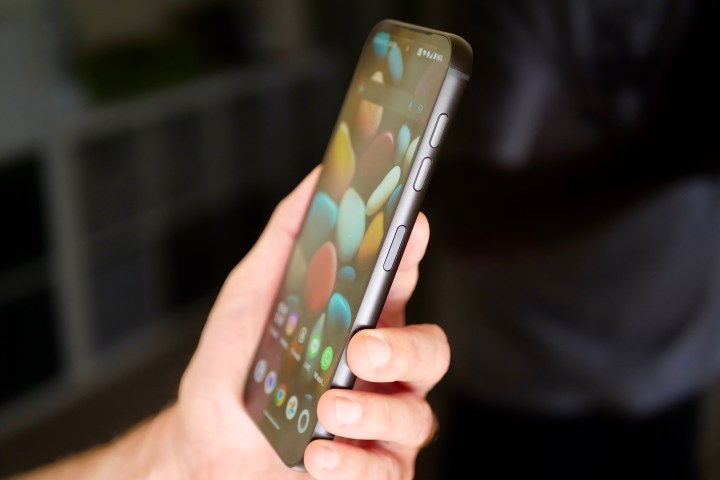
The replaceable, plastic rear panel makes the Fairphone 5 more durable than if it was made of glass, plus it has all been engineered to meet the MIL-STD-810H toughness standard. And even though you can take the phone apart, it has a simple IP55 water- and dust-resistance rating. Considering how you can strip the phone down, any IP rating is a welcome surprise, even if it can’t match the IP68 rating found on the Galaxy S23 or iPhone 14. Apart from the ability to repair the phone yourself, Fairphone also provides a five-year warranty on the phone.
I’ve had total confidence in the Fairphone 5 due to its solidity and repairability, but have also been proud of the way it looks. It’s a great combination, and it’s very clear Fairphone has worked hard to get the mix just right.
Taking photos with the Fairphone 5
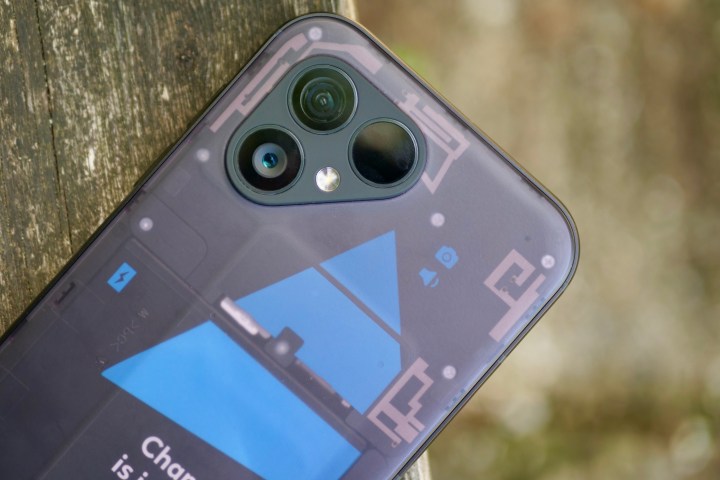
There are three 50-megapixel cameras on the Fairphone 5. The 50MP main camera has optical and electronic image stabilization (OIS and EIS), while the 50MP wide-angle camera has autofocus and a 117-degree field of view. The final 50MP camera is the selfie camera at the top-center of the screen, which takes photos at 12.5MP using pixel binning.
The phone uses familiar old Google Photos as the gallery, but the camera app has a few idiosyncrasies. For example, you either use a less-than-precise slider to switch from the main camera to the wide-angle or have to cycle through a 2x digital zoom mode first when you tap the button. It’s not the speediest solution.

The Qualcomm QCM6460’s shortcomings as a mobile chip show up when you get into the camera. The portrait mode has trouble with edge recognition in a way most other smartphone cameras don’t these days, while night mode photos are bright, but noisy and lacking detail. However, it’s the wide-angle that’s really bad. There’s so much noise and very obvious edge enhancement and smoothing throughout; the images it takes are a real mess.
The main camera is better, with pleasing colors and dynamic range that give photos a lovely tone in the right environment. However, in difficult lighting, it can get the colors wrong, ruining the appearance of the environment. It’s not always terrible — just don’t expect it to impress on every shot or to take on any other modern smartphone in the camera department. I’ve been happy with the selfies it takes too, although I wouldn’t say they’re beyond the quality of any other modern flagship phone, just comparable.
For me personally, the camera’s performance puts me off owning the Fairphone 5 for a year, let alone the next eight or 10 years. But I appreciate that not everyone values the camera, and it’s certainly not something that Fairphone pushes as a primary reason to buy the phone.
I’d also hope future software updates improve the wide-angle camera’s performance. Ultimately, if you really want the Fairphone 5, but love taking photos, I’d suggest getting a regular camera to go along with it. That may not be particularly eco-conscious, but if you really care about camera quality, it’s something you’ll need to consider.
The Fairphone 5’s software, performance, and screen
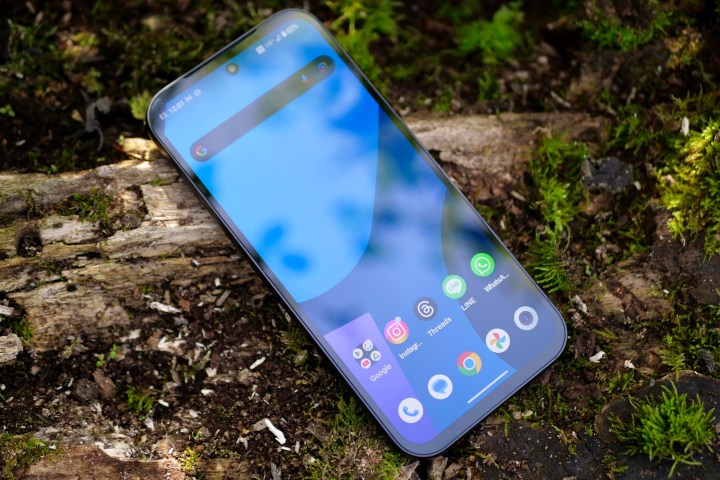
Fairphone has made the sensible decision to install an unmolested user interface over Android 13, making it clean to look at and fast to use. It shares many design aspects with the interface on the Google Pixel 7 series, but there are some features missing. In addition to the slightly odd camera app, when you change the wallpaper, the icons and buttons all take on a contrasting hue, but you can’t override this in any way. It’s also annoying you can’t remove the Google Search bar from the home screen.
Despite the Fairphone 5 not using a recognizable processor like the Qualcomm Snapdragon 8+ Gen 1 found in the Nothing Phone 2, it doesn’t seem to affect performance in any way. Social apps, email, and the interface are all snappy, and simple games like Pocket City run without a problem.

More challenging games like Asphalt 9: Legends are fine at the default settings, and while I played without a problem, it’s not the smoothest gaming phone. Despite not being a regular phone chip, it still has all the usual features ,from 5G connectivity to NFC for mobile payments. It has pulled in a good network signal, plus calls are clear for both parties. Simply put, don’t be put off by a chip name you don’t recognize.
The flat, 6.46-inch OLED screen has a 2,700 x 1,224 pixel resolution, is covered in Gorilla Glass 5, and is bright enough to be used outside in sunlight. The attractive colors and warmth make photos taken with the Fairphone 5 look good on it. It has a switchable rather than dynamic refresh rate, which may be another reason for the battery not lasting longer than a day for me, as I’ve had it permanently on 90Hz. I’m sure the battery will last a little longer if the screen is set at 60Hz, but I’d rather have smoother scrolling and less eye strain. The auto-brightness is also almost always at its maximum level, another potential battery draw.
The Fairphone 5 is comfortable and friendly to use, and the software is unobtrusive and free from unwanted apps. Within moments of setting it up, I felt entirely at home with it, and it has been completely reliable so far. Compared to the busy, feature-packed experience found on phones like the Oppo Reno 10, it’s a breath of fresh air and will be preferable to anyone put off by the mostly fuss-free, but hyper-stylized software on the Nothing Phone 2.
Fairphone 5 price and availability
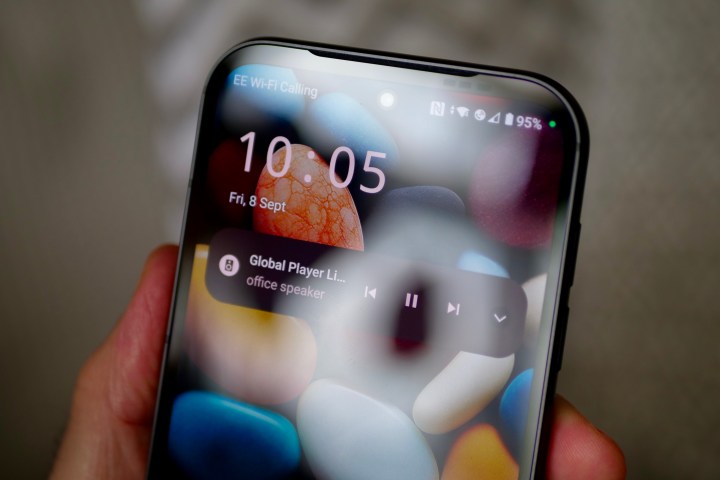
The Fairphone 5 is not currently available to buy in the U.S., but it is in parts of Europe and the U.K., where it costs 619 British pounds (or 699 euros). This converts over to around $755. There’s only one version available, with 8GB of RAM and 256GB of storage space, but the phone does have a MicroSD card slot to increase this. Fairphone did release the Fairphone 4 in the U.S. and may do something similar with the Fairphone 5 in the future, though that hasn’t been confirmed yet.
Considering the Fairphone 5’s specifications, it is on the pricey side, but to call it expensive misses the point. This is a relatively low-volume phone, and Fairphone’s production methods, sourcing of materials, and commitment to fair wages will obviously impact the final cost to you, the buyer. But it’s also repairable, which along with the durability and extended warranty, makes it excellent value if you do keep it long-term. Most people will accept the somewhat higher than-usual price when looking at it this way.
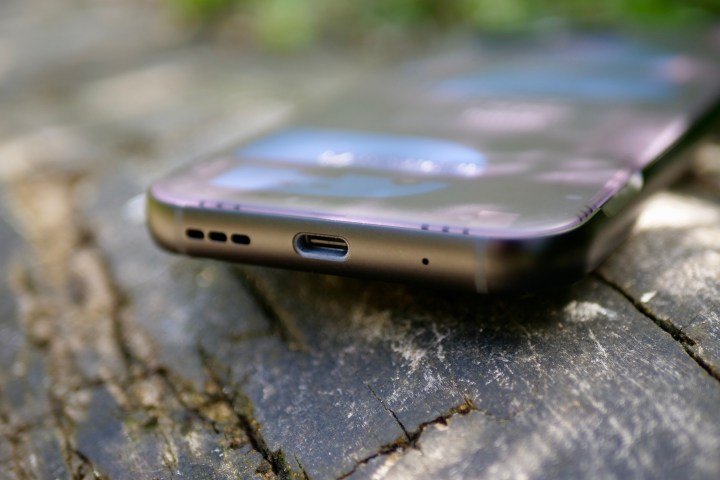
But what the price also does is put the Fairphone 5 alongside some very tempting competing smartphones. The Apple iPhone 14, the Samsung Galaxy S23, the OnePlus 11, and the Google Pixel 7 all cost around the same and are higher-performance devices. It’s also more expensive than great phones like the Google Pixel 7a and the Nothing Phone 2. But none can match the Fairphone 5’s environmental commitment or its software update policy, and none of them are as public about its fair treatment of the people linked with its business.
This is why it’s hard to compare them directly, as the Fairphone 5 does something very different from the other phones available, almost regardless of price. It’ll attract a very different kind of buyer due to this as well. If repairability is high on your list of requirements, only HMD Global’s 4G Nokia G22 and 5G Nokia G42 come close.
Will you want to keep the Fairphone 5 for a decade?
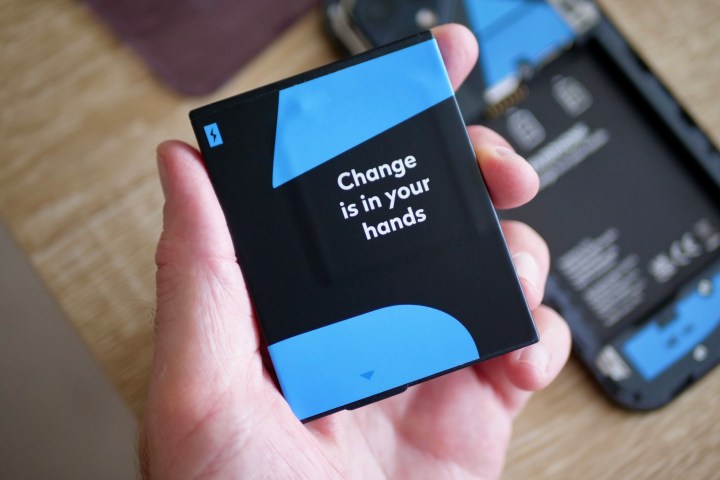
If you’re going to buy the Fairphone 5, you should be doing so with the intention of keeping it for many years, and far longer than you may consider doing with a different phone. Otherwise, you’re not taking advantage of all of Fairphone’s efforts or exploiting its main selling point. If you’re willing to do this, the good news is the Fairphone 5 looks, feels, and performs like a phone you’ll want to use for a while, but only if you don’t care about the camera and buy a second battery.
The camera is a problem. Everything aside from the main and selfie camera is bad, with the wide-angle being one of the worst I’ve seen in a while. And if it’s rubbish today, it’ll be really rubbish in a few years. But the Fairphone 5 isn’t being sold as a camera superstar, and its appeal lies elsewhere, so it’s unfair to really judge it harshly. Ignore it, and Fairphone has managed to make a phone that’s both capable and desirable while still being sustainable and respectfully produced.
The other point to consider before buying is that I can only assess the phone today. I know from experience that many other current smartphones, especially expensive flagships, will operate in a similar way and be just as capable two or three years into ownership. It’s extremely hard to say if the Fairphone 5 will still be as good (camera aside) as it is today, that all the promised software updates will arrive, and if the device will still satisfy your mobile requirements in eight or even 10 years’ time. But this is the time frame Fairphone expects (hopes?) you to commit to after buying it.
Fairphone has managed to make a phone that’s both capable and desirable, while still being sustainable and respectfully produced.
Whether you’re prepared to will ultimately come down to your own personal feelings, but based on using it in 2023, the Fairphone 5 is a good everyday smartphone provided you’re not a photographer, and it should represent incredible value for money if you keep it for years. If you change your phone each year and aren’t ready to change your ways just yet, plus you prioritize camera ability and gaming performance, you will want to look elsewhere.
Editors’ Recommendations
- The best camera phones in 2023: our top 9 photography picks
- The best Samsung phones in 2023: our 8 favorite Galaxy handsets
- The best iPhone 14 cases: 20 best ones you can buy in 2023
- The best iPhone apps in 2023: Our filtered list of apps you need to download now
- Some Android phones are about to get superpowerful AI apps


